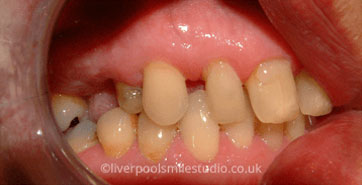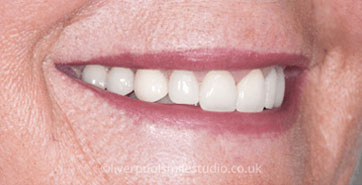Bridges are used to fill in gaps and replace missing teeth. These are used as a very viable alternative to dentures if the surrounding teeth are strong enough to support the bridge. They are permanent and less bulky than dentures.
Bridges are attached to neighbouring teeth and just like crowns, and are made from porcelain, metal or a combination of both. The colour is matched to your existing teeth so they look very natural. A bridge can make such a difference to your mouth and allow you to eat, talk and smile with confidence.
There are many bridge designs. A typical bridge is illustrated here. The natural teeth either side of the space have been prepared to have crowns (or "caps") fitted. These crowns are permanently fused to an artificial tooth in the centre.

Before

After
Not everyone is a suitable candidate for a dental bridge. The success and longevity of a dental bridge depend on several factors, including the individual's oral health and the type of bridge required.
To have a dental bridge, an individual must have healthy adjacent teeth to act as support for the bridge. In the case of a traditional bridge, neighbouring teeth on both sides of the gap must be strong enough to handle the pressure and force of the artificial tooth in between them. If these teeth are weak or compromised, a bridge may not be a feasible option.
Similarly, an individual's gum tissue and jawbone structure must also be healthy enough to support the bridge. In cases of bone loss or gum disease, a bridge may not be the ideal choice unless additional treatment is completed to restore oral health.
Another factor to consider is the type of bridge required. Traditional bridges require the removal of some of the healthy tooth structure in neighbouring teeth to make room for the bridge. For individuals who have strong, healthy teeth surrounding the gap, other options like implant-supported bridges may be a better alternative.
Ultimately, whether a dental bridge is suitable for an individual depends on a case-by-case evaluation by a dental professional. A treatment plan can be tailored to the individual's unique needs and oral health status to ensure the best possible outcome.
In conclusion, not everyone is a candidate for a dental bridge. A thorough evaluation by a dental professional is necessary to determine an individual's suitability for a bridge and the best treatment plan to restore their oral health and natural smile.
Dental bridges are a common solution for replacing missing teeth, offering a natural-looking and functional option that can help improve oral health and confidence. However, for those considering a dental bridge, a common question is how long it will last.
The lifespan of a dental bridge can vary depending on several factors. In general, a dental bridge can last anywhere from 5 to 15 years or more with proper care. However, some bridges may need to be replaced sooner due to wear and tear or other factors.
One crucial factor in the longevity of a dental bridge is proper oral hygiene. Regular brushing and flossing can help keep the artificial tooth and surrounding teeth clean and free from decay. Additionally, regular dental check-ups are essential to ensure the bridge is in good condition and to detect any potential problems early on.
The type of bridge can also impact its lifespan. Traditional bridges, which rely on neighbouring teeth for support, may weaken the healthy teeth over time and cause them to become compromised, leading to the need for a replacement. Implant-supported bridges, on the other hand, can be a more durable option, as they rely on artificial tooth roots that are inserted into the jawbone.
Other factors that can impact the lifespan of a dental bridge include the individual's bite, the strength and health of neighbouring teeth, the material used for the bridge, and the amount of wear and tear the bridge experiences over time.
Ultimately, the best way to ensure a dental bridge lasts as long as possible is to practice proper oral hygiene and schedule regular check-ups with a dental professional. With proper care and maintenance, a dental bridge can provide many years of a healthy and beautiful smile.
A bridge can be used to replace up to five missing teeth, without the need for implants or dentures—making it an economical choice for many people. Bridges require little maintenance and provide a permanent solution for multiple missing teeth.
The number of teeth that can be replaced depends on the type of bridge you choose and its design. Traditional bridges are the most common type and usually span at least three (or up to five) locations between existing natural teeth. This allows the bridge to restore chewing function as well as improve your appearance by replacing missing front or back teeth. If you have more than five gaps in your smile, you may want to consider alternative options like dental implants or removable dentures. Your dentist will help you determine which option is best for you based on your overall dental health, budget, and personal preferences.
"James Bennett is a dental wizard !! Had two crowns and veneers .. Made a massive difference to my smile .. Excellent dentist great customer service from top to bottom .. Clare Leary on Reception explains everything in Black and White 5 star work and service Thank you!"